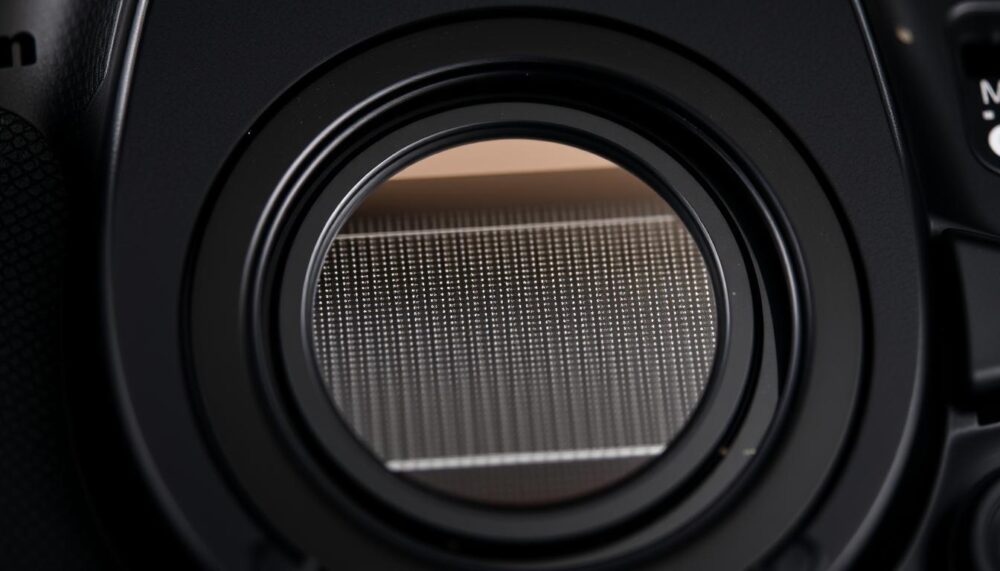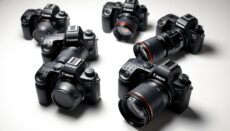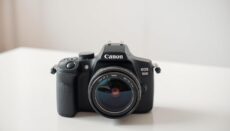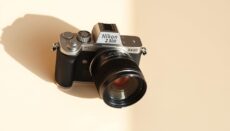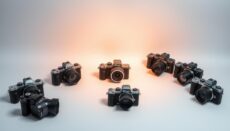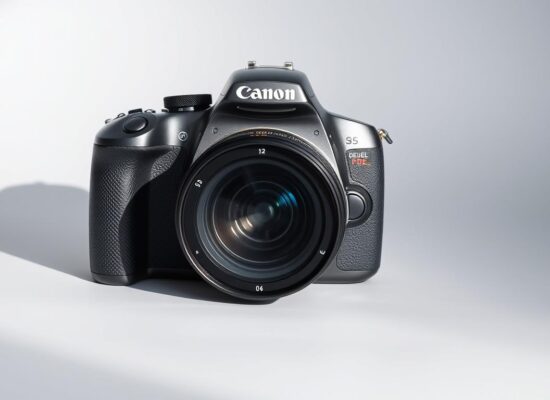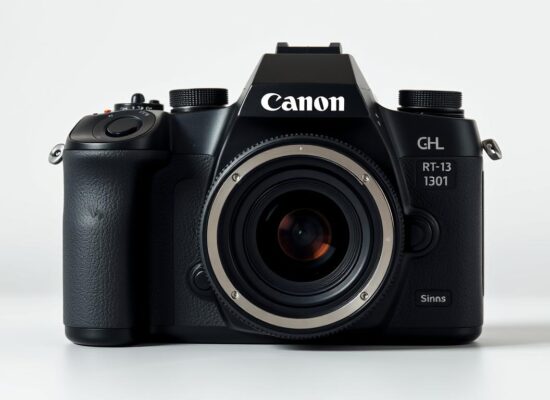The Canon EOS 70D remains a popular choice among photography enthusiasts. Many wonder whether it features a full-frame or crop sensor. The answer lies in its APS-C sensor, which offers a 1.6x focal length multiplier. This design makes it ideal for capturing detailed shots with a narrower field of view.
One standout feature of this model is the Dual Pixel CMOS AF system. It revolutionises autofocus performance, especially for video recording. With a 20.2MP resolution, the device delivers sharp, high-quality images. Additionally, built-in Wi-Fi enhances connectivity, allowing seamless sharing and remote control.
Understanding the implications of its sensor type is crucial for photographers. It affects lens compatibility, depth of field, and overall image quality. This article delves into these aspects, providing a comprehensive analysis of the 70D’s capabilities.
Key Takeaways
- The Canon EOS 70D uses an APS-C crop sensor.
- It features a 1.6x focal length multiplier.
- The Dual Pixel CMOS AF system enhances autofocus performance.
- It boasts a 20.2MP resolution for high-quality images.
- Built-in Wi-Fi allows for easy sharing and remote control.
Introduction to the Canon 70D
Introduced in July 2013, the Canon EOS 70D quickly became a favourite among photography enthusiasts. This mid-range DSLR combines versatility with advanced features, making it ideal for hybrid shooters who need both stills and video capabilities.
At its core, the device boasts a 20.2MP APS-C sensor, ensuring sharp and detailed images. Paired with the DIGIC 5+ processor, it delivers excellent performance even in challenging lighting conditions. The ISO range of 100-12,800, expandable to 25,600, further enhances its adaptability.
Positioned between Canon’s Rebel series and the 7D, the EOS 70D strikes a balance between affordability and professional-grade features. Its innovative Dual Pixel CMOS AF system revolutionises autofocus, particularly for video recording. Additionally, compatibility with STM lenses ensures smooth and quiet focusing, perfect for capturing high-quality footage.
Targeting hybrid shooters, this model excels in both photography and videography. The articulating touchscreen and built-in Wi-Fi add to its appeal, offering flexibility and convenience. Whether you’re a seasoned enthusiast or an aspiring professional, the Canon EOS 70D remains a compelling choice.
Understanding Sensor Types: Full-Frame vs Crop Sensor
Understanding sensor types is essential for making informed photography choices. The two primary categories are full-frame and crop sensors. Each has distinct characteristics that influence performance and usability.
Full-frame sensors measure 36x24mm, offering a wider field of view. In contrast, APS-C sensors, like the one in the Canon EOS 70D, measure 22.5x15mm. This smaller size results in a 1.6x focal length multiplier, altering how lenses behave. For example, a 50mm lens effectively becomes an 80mm lens on a crop sensor.
Light-gathering capabilities also differ. Full-frame sensors generally perform better in low light due to their larger surface area. Depth of field is another factor; full-frame sensors produce a shallower depth of field, ideal for portraits. Crop sensors, however, excel in telephoto applications, providing extra reach without additional equipment.
Comparing sensor sizes across brands reveals subtle differences. Canon’s APS-C sensors are slightly smaller than Nikon’s DX format. This variation can influence lens compatibility and image quality. Below is a detailed comparison:
| Brand | Sensor Type | Dimensions (mm) | Crop Factor |
|---|---|---|---|
| Canon | APS-C | 22.5×15 | 1.6x |
| Nikon | DX | 23.6×15.6 | 1.5x |
Addressing misconceptions, many assume full-frame sensors are inherently “professional.” While they offer advantages, crop sensors like the APS-C are highly capable. They are more affordable, lighter, and often better suited for specific applications such as wildlife or sports photography.
Ultimately, the choice between full-frame and crop sensors depends on individual needs. Both have unique strengths, and understanding these differences ensures the right decision for your photography journey.
Is My Canon 70D a Full-Frame Camera?
Photographers often question whether the Canon 70D features a full-frame sensor. The answer is clear: it uses an APS-C crop sensor. This design provides a 1.6x focal length multiplier, altering how lenses perform compared to full-frame models.
When compared to Canon’s 5D or 6D series, the differences are significant. Full-frame sensors measure 36x24mm, while the 70D’s APS-C sensor is smaller at 22.5x15mm. This size discrepancy results in a narrower field of view and an increased effective focal length. For instance, a 50mm lens behaves like an 80mm lens on the 70D.
Despite not being a full-frame camera, the 70D offers distinct advantages. Its crop sensor enhances telephoto reach, making it ideal for wildlife or sports photography. Additionally, lenses designed for APS-C sensors are often smaller and lighter, adding to the device’s portability.
Confusion sometimes arises due to the naming conventions of Canon’s 5D series. While both share similar numbering, the 70D is firmly in the crop sensor category. Understanding this distinction ensures photographers make informed decisions about their equipment.
| Model | Sensor Type | Dimensions (mm) | Crop Factor |
|---|---|---|---|
| Canon 70D | APS-C | 22.5×15 | 1.6x |
| Canon 5D Mark IV | Full-Frame | 36×24 | 1x |
In summary, the Canon 70D’s APS-C sensor sets it apart from full-frame models. Its design offers unique benefits, particularly for those needing extra reach or lighter gear. Knowing these details helps photographers maximise the device’s potential.
The Canon 70D’s APS-C Sensor Explained
Delving into the technical aspects of the Canon 70D’s sensor reveals its impressive capabilities. The 22.5x15mm active area houses 20.2 million photosites, ensuring high resolution and sharp image quality. This design makes it a versatile choice for various photography styles.
One standout feature is the Dual Pixel CMOS structure. Each pixel contains two photodiodes, enabling phase detection across 80% of the frame. This innovation enhances autofocus performance, particularly for video recording and live view shooting.
In low-light conditions, the sensor performs admirably. Real-world tests at ISO 12,800 demonstrate its ability to capture usable images in challenging environments. However, dynamic range limitations become apparent when compared to contemporary Nikon sensors.
The evolution from earlier models, such as the 60D’s 18MP sensor, highlights Canon’s commitment to improvement. The 70D’s 20.2MP resolution and 4.1µm pixel pitch represent a significant step forward in image quality and detail retention.
- Technical breakdown: 22.5x15mm active area, 20.2 million photosites.
- Dual Pixel CMOS structure: Two photodiodes per pixel for phase detection.
- Low-light performance: Real-world tests at ISO 12,800 in gallery settings.
- Dynamic range limitations compared to contemporary Nikon sensors.
- Evolution from earlier models (60D’s 18MP to 70D’s 20.2MP).
Dual Pixel CMOS AF: A Game-Changer for the Canon 70D
The Dual Pixel CMOS AF system marked a significant leap in autofocus technology. It introduced on-sensor phase detection, covering 80% of the frame. This innovation ensured faster and more accurate focus, particularly in live view and video modes.
In live view, the system excelled with features like face tracking and touch-to-focus accuracy. These capabilities made it easier to capture sharp images and smooth video footage. Compared to traditional contrast-detect systems, the Dual Pixel CMOS AF offered superior performance.
Real-world tests demonstrated seamless focus pulls during video recording. The system’s ability to handle low-light conditions down to 0 EV further enhanced its versatility. However, it lacked advanced features like eye detection, which are now common in modern mirrorless systems.
- Technical innovation: First DSLR with on-sensor phase detection.
- Live View/Movie mode benefits: Face tracking, touch-to-focus accuracy.
- Comparison to traditional contrast-detect systems in other DSLRs.
- Real-world test: Seamless focus pulls during video recording.
- Limitations: No eye detection like modern mirrorless systems.
Overall, the Dual Pixel CMOS AF system redefined autofocus capabilities, making the device a standout choice for hybrid shooters. Its blend of speed, accuracy, and versatility remains a benchmark in its class.
Canon 70D Sensor Performance in Low Light
Low-light photography demands a sensor that balances noise reduction with detail retention. The Canon 70D excels in this area, offering a usable ISO range of 3200-6400. Its DIGIC 5+ processor ensures minimal noise, even in challenging conditions.
Comparing noise characteristics across models reveals interesting insights. The 70D outperforms the 60D, with cleaner images at higher ISO settings. However, the 7D still holds a slight edge in image quality due to its more advanced processing capabilities.
For post-processing, photographers recommend using software like Adobe Lightroom. It allows for effective noise reduction while preserving fine details. This approach ensures high-ISO files retain their image quality.
A real-world example highlights the 70D’s capabilities. During gallery shooting without flash, the device captured sharp, detailed images at ISO 12,800. This performance makes it a reliable choice for low-light environments.
Despite its strengths, the 70D has limitations. At base ISO, its dynamic range falls short compared to newer models. This can affect image quality in high-contrast scenes.
| Model | Usable ISO Range | Noise Reduction | Dynamic Range |
|---|---|---|---|
| Canon 70D | 3200-6400 | Excellent | Limited |
| Canon 60D | 1600-3200 | Good | Moderate |
| Canon 7D | 3200-6400 | Excellent | Good |
In summary, the Canon 70D’s sensor delivers impressive performance in low-light conditions. Its noise reduction and usable ISO range make it a versatile tool for photographers. However, its dynamic range limitations should be considered for specific shooting scenarios.
Image Quality and Resolution of the Canon 70D
Capturing stunning visuals hinges on the device’s ability to deliver exceptional detail and clarity. The Canon 70D achieves this with its 20.2MP sensor, offering a significant upgrade over the 60D’s 18MP. This enhancement ensures sharper images, particularly in landscape and portrait photography.
The resolution of 5472×3648 pixels allows for detailed captures, preserving fine textures and intricate patterns. Improved JPEG processing further enhances image quality, delivering vibrant colours and accurate skin tones. Canon’s trademark colour science ensures natural rendering, especially in portrait shots.
When comparing RAW and JPEG formats, the differences become apparent. RAW files retain more recoverable highlight and shadow detail, offering greater flexibility in post-processing. JPEGs, however, provide ready-to-use images with balanced exposure and colour.
Lens choice plays a crucial role in maximising image quality. Pairing the device with L-series glass ensures optimal sharpness and minimal distortion. This combination is ideal for professional-grade results.
For print enthusiasts, the 20.2MP sensor supports high-quality prints at 300dpi. Below is a detailed breakdown of print size capabilities:
| Print Size (inches) | Resolution (dpi) | Quality |
|---|---|---|
| 8×10 | 300 | Excellent |
| 12×18 | 300 | Good |
| 16×24 | 300 | Acceptable |
In summary, the Canon 70D excels in delivering high image quality and resolution. Its 20.2MP sensor, improved JPEG processing, and compatibility with premium lenses make it a versatile tool for photographers.
Video Capabilities of the Canon 70D
The Canon 70D transformed DSLR video capabilities with its innovative features. It introduced the Dual Pixel CMOS AF system, marking a revolution in autofocus performance. This technology ensured reliable continuous AF, a first for DSLRs, making it a game-changer for hybrid shooters.
Compatibility with STM lenses further enhanced its appeal. These lenses enabled silent focus pulls, ideal for capturing smooth video footage. The combination of the Dual Pixel CMOS AF and STM lenses set a new standard for DSLR video recording.
Codec options included 1080p30/25/24 with ALL-I and IPB compression. ALL-I offered higher bitrates for superior quality, while IPB provided efficient storage. Below is a detailed comparison of the codecs:
| Codec | Bitrate | Best Use |
|---|---|---|
| ALL-I | 90 Mbps | High-quality editing |
| IPB | 30 Mbps | Storage efficiency |
The accessory ecosystem expanded its versatility. External microphones improved audio quality, while HDMI monitoring allowed precise framing. These additions made the device a favourite among indie filmmakers.
Even today, the Canon 70D retains its legacy. Many professionals still use it as a B-camera in productions. Its blend of advanced features and reliability ensures it remains a valuable tool for video enthusiasts.
Canon 70D’s Articulating Touch-Screen Display
One of the standout features of the Canon 70D is its articulating touch-screen display. This 3-inch, 1.04M-dot vari-angle LCD offers flexibility for various shooting scenarios. Whether capturing high or low angles, the screen ensures optimal framing and composition.
The touch interface simplifies navigation and focus point selection. During live view or video recording, users can tap the screen to adjust focus quickly. This functionality enhances efficiency, especially for vloggers or hybrid shooters.
Compared to fixed screens, like the Nikon D7100, the Canon 70D’s articulating design provides greater versatility. It allows for creative shooting positions, such as self-portraits or macro work. The ability to tilt and swivel the screen ensures comfort in challenging environments.
Sunlight visibility is another advantage. The anti-smudge coating reduces glare and fingerprints, maintaining clarity even in bright conditions. This feature is particularly useful for outdoor photography or video recording.
Creative uses of the articulating screen extend beyond traditional photography. It enables unique perspectives, such as ground-level shots or overhead angles. For macro enthusiasts, the vari-angle display simplifies precise framing of intricate subjects.
In summary, the Canon 70D’s articulating touch-screen display combines practicality with innovation. Its flexibility, touch functionality, and durability make it a valuable tool for photographers and videographers alike.
Built-In Wi-Fi and Remote Control Features
Modern photographers demand seamless connectivity in their devices. The Canon EOS 70D meets this need with its built-in Wi-Fi and remote control capabilities. These features streamline workflows, enabling wireless file transfers and remote shooting via smartphones or tablets.
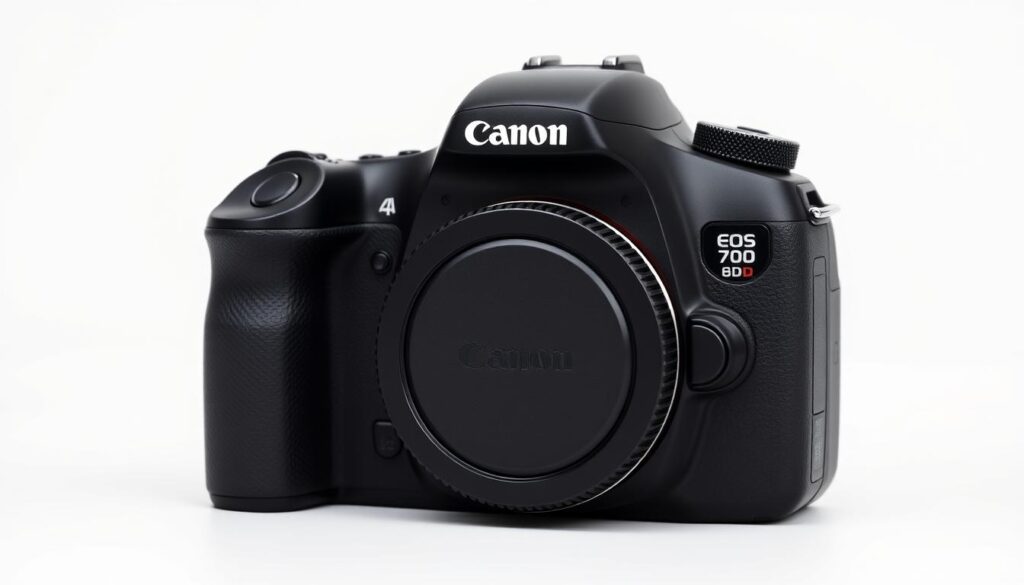
Setting up the built-in Wi-Fi is straightforward. Users connect their devices through the Canon Camera Connect app, available for iOS and Android. This app allows for live view shooting, focus adjustments, and instant image sharing. It’s particularly useful for group photos or wildlife photography, where remote triggers ensure precise timing.
Security is a priority with password-protected connections. This ensures unauthorised devices cannot access the camera. However, the Canon EOS 70D lacks GPS tagging, a feature found in the 6D. This omission may limit geotagging capabilities for some users.
Firmware updates have the potential to enhance functionality. While the current mode offers robust features, future updates could expand compatibility or improve performance. Below is a summary of the key features and limitations:
| Feature | Details |
|---|---|
| Built-in Wi-Fi | Wireless file transfer, remote control via app |
| Remote Control | Live view shooting, focus adjustments |
| Security | Password-protected connections |
| Limitations | No GPS tagging |
In summary, the Canon EOS 70D’s built-in Wi-Fi and remote control features offer significant advantages. They enhance flexibility and efficiency, making the device a valuable tool for modern photographers.
Canon 70D’s Continuous Shooting Speed
Capturing fast-moving subjects requires a camera with impressive burst capabilities. The Canon 70D delivers a continuous shooting speed of 7 frames per second (fps), a significant upgrade from the 60D’s 5.3fps. This makes it ideal for sports, wildlife, and action photography.
With a buffer capacity of 65 JPEGs or 16 RAW files, the device handles extended bursts efficiently. However, using UHS-I memory cards is recommended to maximise performance and minimise delays during continuous shooting.
When compared to the 7D’s 8fps, the 70D’s speed is slightly lower but still competitive. Mirrorless models, like the Sony A6000, offer faster burst rates but often lack the robust build and lens compatibility of DSLRs.
Real-world tests demonstrate the 70D’s ability to capture sharp action sequences. The Servo AF system ensures consistent focus during bursts, even with moving subjects. This feature is particularly useful for tracking athletes or wildlife.
| Model | Burst Speed (fps) | Buffer Capacity |
|---|---|---|
| Canon 70D | 7 | 65 JPEG / 16 RAW |
| Canon 7D | 8 | 130 JPEG / 25 RAW |
| Sony A6000 | 11 | 49 JPEG / 22 RAW |
In summary, the Canon 70D’s continuous shooting speed and reliable focus make it a versatile tool for capturing dynamic moments. Its blend of speed, buffer capacity, and tracking performance ensures it remains a favourite among action photographers.
Comparing the Canon 70D to Other Canon Models
When evaluating the Canon 70D, comparing it to other models in the EOS lineup provides valuable insights. Each device offers unique features, catering to different photography needs.
Against the 60D, the EOS 70D stands out with improved autofocus, a higher resolution sensor, and built-in Wi-Fi. These upgrades make it a more versatile choice for modern photographers.
In contrast to the 7D, the 70D focuses on user-friendly features like an articulating touchscreen. However, the 7D boasts a more rugged build and faster continuous shooting, making it ideal for demanding environments. For a detailed comparison, check out Canon 70D and 7D compared.
The 80D introduces a 24MP sensor and a 45-point autofocus system, enhancing both resolution and performance. These improvements make it a natural successor to the 70D.
When compared to the 6D, the 70D’s crop sensor offers advantages in telephoto reach, while the 6D’s full-frame design excels in low-light scenarios. Each has distinct strengths depending on the photographer’s needs.
- 70D vs 80D: Resolution bump and AF improvements.
- 70D vs 7D: Build quality vs modern features.
- 70D vs 6D: Crop vs full-frame trade-offs.
In the second-hand market, the EOS 70D remains competitive against newer Rebel models. Its blend of features and affordability ensures it stays relevant, even a decade after its release.
Despite being launched in 2013, the Canon 70D continues to hold its own. Its balanced performance and adaptability make it a reliable choice for photographers in 2023.
Canon 70D’s Lens Compatibility and Kit Options
Exploring the lens options for the Canon 70D reveals its versatility. The device features an EF/EF-S mount, supporting a wide range of Canon and third-party lenses. This compatibility ensures photographers can adapt the camera to various photography styles, from landscapes to portraits.
Two popular kit options include the 18-55mm STM and 18-135mm STM lenses. The 18-135mm STM, in particular, stands out as a video workhorse. Its smooth autofocus and versatile focal length make it ideal for hybrid shooters.
For those seeking additional flexibility, several lenses are highly recommended. The 10-18mm STM excels in wide-angle shots, while the 24mm pancake offers compact portability. The 50mm f/1.8, known as the “nifty fifty,” delivers excellent low-light performance and shallow depth of field.
Third-party options like Sigma ART and Tamron G2 series further expand the possibilities. These lenses provide professional-grade optics at competitive prices, making them a favourite among enthusiasts.
The 1.6x crop factor of the APS-C sensor enhances telephoto reach. This feature is particularly beneficial for wildlife or action photography, where extra magnification is crucial. Adapters for EF to RF mounts are available, though with some limitations in functionality.
| Lens | Best Use |
|---|---|
| 10-18mm STM | Wide-angle landscapes |
| 24mm pancake | Compact street photography |
| 50mm f/1.8 | Portraits and low light |
| 18-135mm STM | Versatile video and travel |
In summary, the Canon 70D’s lens compatibility and kit options make it a versatile tool for photographers. Whether using native or third-party lenses, the device adapts to diverse creative needs, ensuring exceptional results.
User Experience: Pros and Cons of the Canon 70D
Evaluating the user experience of the Canon 70D reveals a mix of strengths and weaknesses. This mid-range DSLR combines innovative features with some limitations, making it a versatile yet imperfect choice for photographers.
One of its standout strengths is the Dual Pixel CMOS AF system. This technology revolutionises autofocus, particularly for video recording. The articulating touch-screen display adds flexibility, allowing for creative shooting angles. Built-in Wi-Fi enhances connectivity, enabling seamless file sharing and remote control.
However, the device has its drawbacks. The dynamic range falls short compared to newer models, limiting image quality in high-contrast scenes. Its plastic build, while lightweight, lacks the durability of magnesium alloy competitors. Additionally, the aging sensor technology and single card slot may deter professionals seeking advanced features.
Ergonomics are a highlight, with a comfortable grip that suits extended shooting sessions. Yet, the menu system feels outdated when compared to modern mirrorless cameras. The learning curve is manageable, but some users may find it less intuitive than newer alternatives.
Long-term reliability is generally positive, with reports of robust shutter durability. However, the device’s limitations in dynamic range and build quality may affect its appeal for demanding environments.
| Aspect | Strengths | Weaknesses |
|---|---|---|
| Autofocus | Dual Pixel CMOS AF | Limited in low light |
| Build | Lightweight | Plastic construction |
| Connectivity | Built-in Wi-Fi | No GPS tagging |
| Image Quality | 20.2MP resolution | Limited dynamic range |
In summary, the Canon 70D offers a compelling blend of features and limitations. Its strengths in autofocus, screen flexibility, and connectivity make it a versatile tool. However, its weaknesses in dynamic range and build quality may influence the decision for some photographers.
Is the Canon 70D Still Worth Buying Today?
In the ever-evolving world of photography, the Canon 70D remains a topic of discussion for its value proposition. With used prices hovering around £500, it presents an affordable option compared to newer models like the £1,200 80D. But does it still hold up in 2023?
The second-hand market offers body-only deals under £400, making it an attractive choice for budget-conscious enthusiasts. Its Dual Pixel CMOS AF system and articulating touchscreen continue to appeal, particularly for video blogging and hybrid shooting.
However, limitations exist when compared to modern mirrorless cameras. The absence of 4K video, eye-AF, and in-body image stabilisation (IBIS) may deter some users. Despite these drawbacks, the device excels in niche roles, such as an affordable B-camera or backup body for filmmakers.
- Second-hand market analysis: Body-only deals under £400.
- Niche uses: Affordable video B-camera, backup body.
- Limitations vs mirrorless: No 4K, eye-AF, IBIS.
- Recommended users: Budget filmmakers, DSLR traditionalists.
- Future-proofing considerations: Lens investment strategy.
For those invested in Canon’s EF/EF-S lens ecosystem, the 70D remains a practical choice. Its compatibility with a wide range of lenses ensures long-term usability, even as technology advances.
In summary, the Canon 70D is still worth buying today for specific use cases. Its affordability, reliable performance, and lens compatibility make it a viable option for budget filmmakers and DSLR enthusiasts.
Conclusion
The Canon EOS 70D’s APS-C crop sensor remains a defining feature for photographers. With a 1.6x focal length multiplier, it offers versatility for various shooting scenarios, from landscapes to telephoto applications. This design ensures compatibility with a wide range of lenses, making it a practical choice for enthusiasts.
As a pivotal model in DSLR video evolution, the 70D introduced the Dual Pixel CMOS AF system. This innovation revolutionised autofocus performance, particularly for hybrid shooters. Its legacy continues to influence modern photography and videography, even as technology advances.
While the device shows its age in some areas, it remains competent for specific uses. Budget-conscious filmmakers and DSLR traditionalists will find it a reliable tool. Its affordability and lens compatibility make it a viable option in 2023.
In conclusion, the Canon EOS 70D stands as a testament to Canon’s innovation. Its blend of features, particularly the Dual Pixel system, ensures it remains relevant for those seeking a balance of performance and value.
FAQ
Does the Canon 70D feature a full-frame sensor?
No, the Canon 70D uses an APS-C crop sensor, which is smaller than a full-frame sensor but offers excellent performance for its class.
What is the advantage of the Dual Pixel CMOS AF in the Canon 70D?
The Dual Pixel CMOS AF enhances autofocus during live view and video recording, providing smoother and more accurate focusing for both stills and movies.
How does the Canon 70D perform in low-light conditions?
With its APS-C sensor and ISO range up to 12800 (expandable to 25600), the Canon 70D delivers decent low-light performance, though it may not match full-frame cameras in extreme conditions.
Can I use full-frame lenses on the Canon 70D?
Yes, the Canon 70D is compatible with EF and EF-S lenses. Full-frame EF lenses work seamlessly, but the crop factor will affect the effective focal length.
What are the video recording capabilities of the Canon 70D?
The Canon 70D supports Full HD 1080p video recording at 30fps, with smooth autofocus thanks to its Dual Pixel CMOS AF technology, making it a solid choice for videographers.
Does the Canon 70D have built-in Wi-Fi?
Yes, the Canon 70D features built-in Wi-Fi, allowing for remote control via a smartphone app and easy sharing of images and videos.
What is the continuous shooting speed of the Canon 70D?
The Canon 70D offers a continuous shooting speed of up to 7 frames per second, making it suitable for capturing fast-moving subjects.
How does the Canon 70D compare to other Canon models?
The Canon 70D sits between entry-level and professional models, offering advanced features like Dual Pixel CMOS AF and an articulating touchscreen, making it a versatile choice for enthusiasts.
Is the Canon 70D still a good buy in today’s market?
Despite being an older model, the Canon 70D remains a reliable and capable DSLR, especially for those seeking a balance of performance and affordability.

